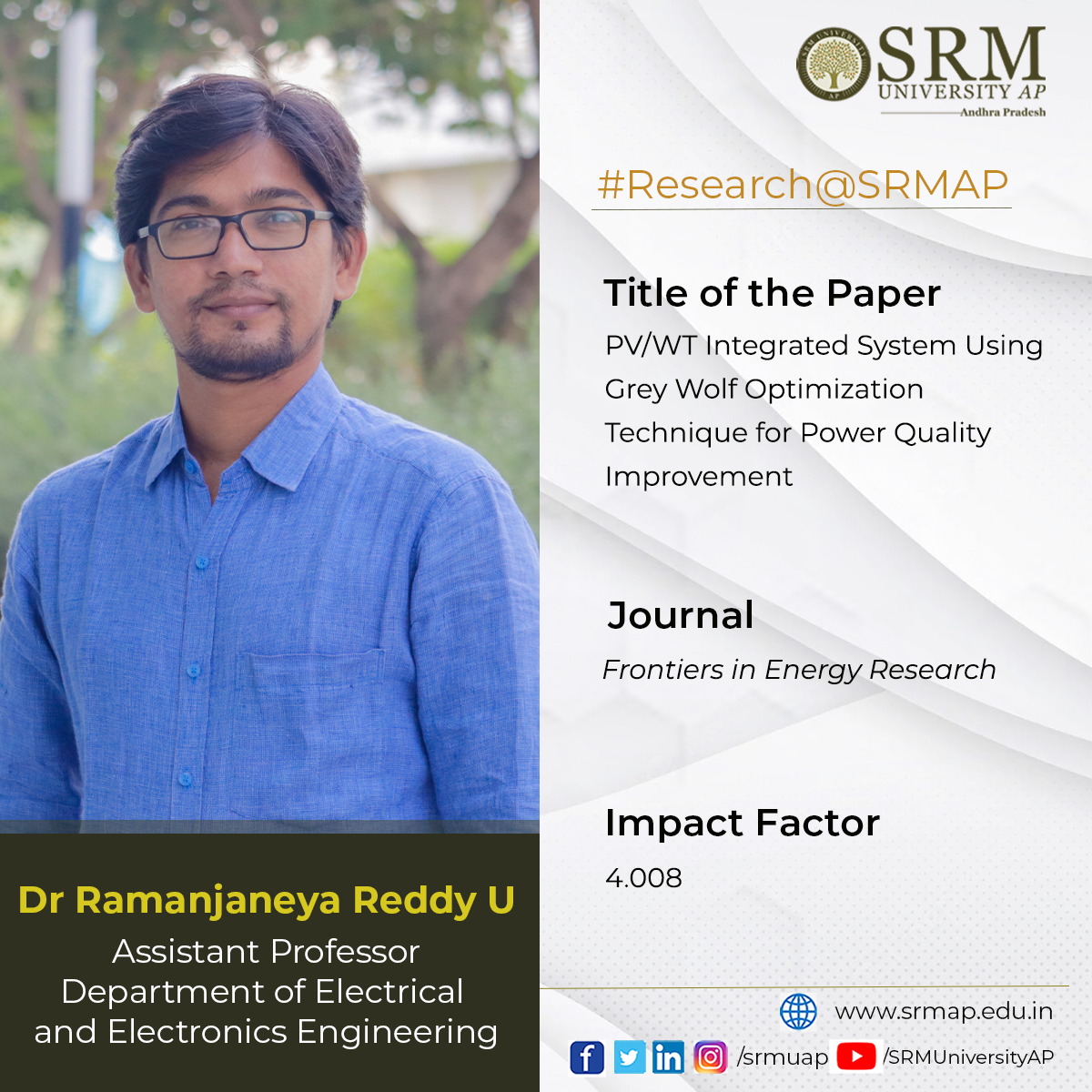 In future, there is a lot of scope for enhancing the power quality using various controllers whose gains are obtained using different optimisation techniques to mitigate several issues. Assistant Professor Dr Ramanjaneya Reddy, Department of Electrical and Electronics Engineering, envisions this tomorrow through his new research paper PV/WT Integrated System Using Grey Wolf Optimization Technique for Power Quality Improvement. The paper is published in the Process, and Energy Systems Engineering section of the Frontiers in Energy Research journal and has an impact factor 4.008. For this research paper, he has collaborated with Assistant Professor Srikanth Goud, Anurag College of Engineering Ghatkesar, Telangana.
In future, there is a lot of scope for enhancing the power quality using various controllers whose gains are obtained using different optimisation techniques to mitigate several issues. Assistant Professor Dr Ramanjaneya Reddy, Department of Electrical and Electronics Engineering, envisions this tomorrow through his new research paper PV/WT Integrated System Using Grey Wolf Optimization Technique for Power Quality Improvement. The paper is published in the Process, and Energy Systems Engineering section of the Frontiers in Energy Research journal and has an impact factor 4.008. For this research paper, he has collaborated with Assistant Professor Srikanth Goud, Anurag College of Engineering Ghatkesar, Telangana.
Abstract
This work presents the integration of renewable energy sources such as PV and wind into the grid. Hybrid shunt active power filter (HSHAPF) is optimised with the grey wolf optimisation (GWO) and fractional order proportional integral controller (FOPI) for harmonic reduction under non-linear and unbalanced load conditions. With the use of GWO, the parameters of FOPI are tuned, effectively minimising the harmonics. The proposed model has effectively compensated the total harmonic distortions (THD) when compared with filter, without filter, with passive filter, active power filter with PI controller, and GWO- FOPI-based controller. The performance of the proposed controller is tested under non-linear and unbalanced conditions. The parameters of the FOPI controller are better tuned with the GWO technique. The comparative results reflect the best results of GWO-FOPI based HSHAPF. The suggested controller is built in the MATLAB/Simulink Platform.
Explanation of the research
Power quality (PQ) problems in the distribution system occur when non-linear loads are used. With the development in semiconductor technology, the modelling and usage of power electronic devices are increasing on the end-user side. Because of the usage of power, electronic devices give rise to many problems like a disturbance in reactive power, poor power factor, harmonic distortion, etc. These problems cause severe effects on the distribution system, which results in PQ issues. To mitigate PQ issues, there are many controlling techniques that ensure harmonic free. Initially, passive filter usage was widely considered for harmonic elimination and reactive power compensation. Due to various remarkable disadvantages like constant compensation performance, large size, resonance, etc., the usage became less. To mitigate the reactive power compensation and harmonics, active power filters (APF) became more prominent as the performance characteristics are very effective compared to conventional filters. APF is the device that generally produces an equal quantity of harmonics when compared with the load with a phase shift of 1800. These harmonics are injected into the linear PCC, load current harmonics mitigate, and supply becomes sinusoidal. The active power filters are broadly classified as series APF and shunt APF. The basic structure of shunt APF is illustrated in Figure.1, which mitigates the load current harmonics by inserting equal but opposite harmonic compensating current. Several authors have conducted research on grid integration using RES, active power filters, PQ issues, and various types of controllers designed to mitigate in the hybrid integrated system. In this work, THD reduction under non-linear load, unbalanced load without filter, with passive filter, with active power filter using a PI controller, and the proposed controller is introduced, which results in the best reduction of harmonics under various load conditions.
Practical implementation of the research
The proposed system is designed using both passive and active filters. The designed model improves the filer’s compensation characteristics, reducing the disadvantages of both active and passive filters. In this proposed work, HSHAPF is implemented with the combination of LC passive filter and voltage source PWM converter illustrated in Figure. 2, which illustrates the RES and HSHAPF connected to the grid. This design is tested at various loads, such as non-linear loads and unbalanced loads. Both filters’ characteristics are designed to provide the best performance under different operating conditions. To filter out the harmonics, the designed structure is modelled with storage systems using the battery, DC link and switches with antiparallel diodes. At PCC compensating current is injected using a voltage source converter to mitigate the harmonics. To overcome the power rating required for the PWM converter, the system is modelled using both active as well as passive filters to mitigate the harmonics. Here power MOSFETs are used in designing the PWM converters, which is cost-effective. To eliminate the harmonic at the PCC, equal and opposite magnitude harmonic current has to be injected, which also improves the PQ in the distribution system.

